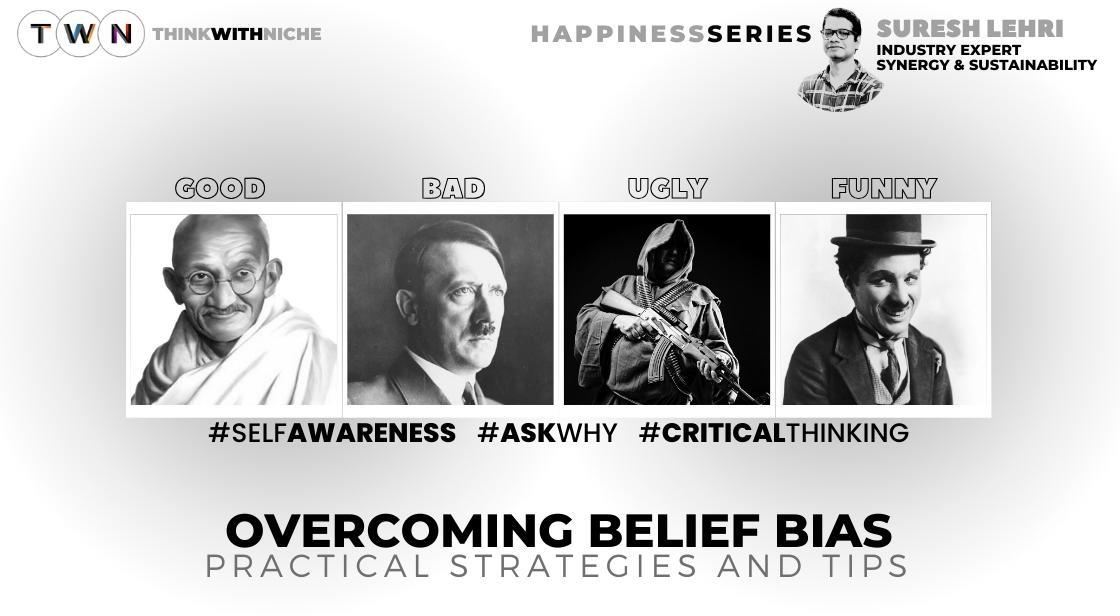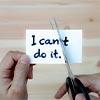Overcoming Belief Bias: Practical Strategies and Tips

Blog Post
In a world saturated with information and constantly evolving beliefs, our ability to make rational and informed decisions can be compromised by a cognitive quirk known as belief bias.
This fascinating but formidable cognitive bias often lurks beneath the surface, influencing the way we perceive new information and navigate the complex terrain of decision-making.
It's the tendency for our existing beliefs, opinions, and personal values to cast shadows over our judgment, steering us toward choices that align with what we already hold dear, rather than what is logically sound.
Belief bias is not confined to the pages of psychology textbooks; it's a ubiquitous force that shapes the contours of our personal and professional lives. It shapes our perceptions, nudging us toward confirmation bias, where we actively seek and embrace information that validates our preconceived notions.
It guides us into the realm of risk aversion, making us hesitant to embrace change or challenge our beliefs. In group settings, it can spawn groupthink, where the desire for consensus overshadows critical analysis, stifling innovation and leading to suboptimal decisions.
In the broader social fabric, belief bias can exacerbate polarization, pushing us into our respective ideological corners, fostering divisiveness, and obstructing constructive dialogue.
In the quest to master the art of decision-making, recognizing belief bias is the first crucial step.
Armed with this knowledge, we can embark on a journey of self-improvement and adopt strategies to overcome its subtle but powerful influence.
In this article, we'll delve into practical strategies and tips to help you break free from the shackles of belief bias and emerge as a more objective, discerning, and informed decision-maker.
It's time to reclaim the reins of your rationality and chart a course toward better choices in both your personal and professional life.
Belief bias is a common cognitive bias that influences our thinking and decision-making. It occurs when our existing beliefs and opinions distort our evaluation of new information or evidence, leading us to make decisions based on what we already believe, rather than what is logically sound. Overcoming belief bias is crucial for making rational and informed choices in both personal and professional life.
In this article, we will delve into practical strategies and tips to help you overcome belief bias and make better decisions.
Overcoming Belief Bias: Practical Strategies and Tips
Understanding Belief Bias
What Is Belief Bias?
Belief bias is a cognitive bias that occurs when individuals' existing beliefs, opinions, or personal values influence their evaluation of new information or evidence. In other words, people tend to favor information that aligns with their preconceived notions and are more likely to dismiss or scrutinize critically any information that contradicts their beliefs. This cognitive bias can lead to irrational decision-making, as individuals may prioritize their existing beliefs over logical reasoning.
Belief bias is a product of cognitive psychology and plays a significant role in shaping our thought processes. It can affect various aspects of life, from personal relationships to professional choices.
The Impact of Belief Bias on Decision-Making Belief bias can have a profound impact on decision-making in several ways:
-
Confirmation Bias: Belief bias often leads to confirmation bias, where individuals actively seek out and accept information that confirms their existing beliefs. This can result in a skewed perception of reality, as contradictory evidence is ignored or downplayed.
-
Risk Aversion: When individuals are influenced by belief bias, they may become risk-averse and avoid decisions or actions that challenge their beliefs. This can hinder personal growth and limit opportunities for innovation.
-
Groupthink: In group settings, belief bias can contribute to groupthink, where consensus is prioritized over critical thinking. This can stifle creativity and lead to poor decision-making.
-
Polarization: Belief bias can exacerbate polarization, as individuals become more entrenched in their own beliefs and less willing to consider alternative viewpoints. This can lead to societal divisions and conflicts.
Real-Life Examples of Belief Bias
Belief bias manifests in various real-life scenarios, demonstrating its pervasive influence:
-
Political Beliefs: People with strong political affiliations may readily accept information that supports their party's ideology while dismissing opposing viewpoints, even if the evidence is compelling.
-
Investment Decisions: Investors may hold onto stocks or assets based on their belief in a company's potential, even when market indicators suggest otherwise. This can lead to financial losses.
-
Medical Choices: Patients may choose alternative treatments or therapies based on their personal beliefs, sometimes rejecting evidence-based medical advice. This can have health consequences.
-
Religious Beliefs: Believers may interpret events or experiences through the lens of their religious faith, attributing them to divine intervention or meaning.
Understanding belief bias is the first step toward mitigating its effects. Recognizing when it influences decision-making allows individuals to adopt strategies to make more rational and objective choices, as we will explore further in this article.
Strategies for overcoming belief bias
1. Recognizing Your Beliefs
Identifying Your Core Beliefs Recognizing and understanding your core beliefs is a crucial step in addressing belief bias. Core beliefs are the fundamental principles and values that shape your worldview and influence your decisions. These beliefs often develop over time through personal experiences, cultural influences, and upbringing. To identify your core beliefs:
-
Self-Reflection: Take time for introspection and journaling. Consider questions like: What values do I hold dear? What principles guide my decisions? What are my most strongly held convictions?
-
Examine Triggers: Pay attention to situations or topics that elicit strong emotional reactions. These can indicate areas where your core beliefs are most pronounced.
-
Ask for Feedback: Seek feedback from trusted friends or family members. They may provide valuable insights into your beliefs and biases that you might not see yourself.
Acknowledging Personal Biases Once you've identified your core beliefs, it's essential to acknowledge your personal biases. Bias refers to the tendency to favor one perspective or group over another, often without rational justification. Understanding your biases allows you to approach decision-making with greater objectivity. Some common biases related to belief bias include:
-
Confirmation Bias: The tendency to seek out information that confirms your existing beliefs while ignoring or downplaying contradictory evidence.
-
Selection Bias: Focusing on specific examples or anecdotes that support your beliefs, even if they don't represent the broader reality.
-
Anchoring Bias: Relying heavily on your initial beliefs or judgments, even when presented with new information.
-
In-Group Bias: Favoring people or groups who share your beliefs while showing prejudice toward those with differing views.
The Role of Self-Reflection Self-reflection is a powerful tool for recognizing your beliefs and biases. It involves introspection and a willingness to explore your thoughts, emotions, and motivations. Here's how self-reflection can help:
-
Increased Awareness: Self-reflection promotes self-awareness by helping you identify patterns in your thinking and behavior. You become more attuned to your beliefs and biases.
-
Emotional Regulation: It allows you to manage strong emotions that may cloud your judgment. When you're aware of your emotional responses, you can respond more thoughtfully.
-
Improved Decision-Making: Self-reflection encourages critical thinking. It prompts you to question your assumptions and consider alternative viewpoints, leading to more informed decisions.
-
Personal Growth: By confronting your beliefs and biases, you can actively work on personal growth and development. You become more adaptable and open to change.
To incorporate self-reflection into your daily life:
-
Set aside dedicated time for introspection, whether through journaling, meditation, or deep thinking.
-
Ask yourself probing questions about your beliefs and reactions to different situations.
-
Be open to feedback from others and use it as an opportunity for self-improvement.
By recognizing your core beliefs, acknowledging your biases, and engaging in self-reflection, you can better navigate belief bias and make more rational, informed decisions. This self-awareness is the foundation for addressing and mitigating the impact of belief bias in your life.
2. Actively Seeking Diverse Perspectives
Embrace Cognitive Diversity Embracing cognitive diversity means valuing and actively seeking out a wide range of perspectives, experiences, and ways of thinking. When you engage with people who have different backgrounds, beliefs, and viewpoints, you gain access to a broader pool of ideas and insights. Here's how to embrace cognitive diversity:
-
Diverse Networks: Cultivate a diverse social and professional network that includes people from various cultural, educational, and professional backgrounds. Engage in conversations and collaborations with individuals who bring unique perspectives to the table.
-
Inclusivity: Create an inclusive environment where people feel comfortable expressing their opinions, even if they differ from your own. Encourage others to share their thoughts and experiences openly.
-
Cross-Disciplinary Collaboration: Collaborate with individuals from different fields or industries. Interdisciplinary collaborations often lead to innovative solutions and a richer understanding of complex issues.
Encourage Dissenting Opinions One effective way to counter belief bias is by actively encouraging dissenting opinions and constructive criticism. Dissenters challenge the prevailing viewpoint and introduce alternative perspectives, which can lead to more well-rounded decisions. Here's how to encourage dissenting opinions:
-
Open Dialogue: Foster an open and respectful communication culture where team members, colleagues, or friends feel safe expressing opposing views. Emphasize that dissent is not only accepted but valued.
-
Devil's Advocate: Assign someone in the group the role of a "devil's advocate" during discussions. Their task is to present counterarguments and challenge prevailing beliefs, stimulating critical thinking.
-
Constructive Feedback: Provide constructive feedback when others offer dissenting opinions. Acknowledge their input and explore it further to assess its validity.
Broaden Your Information Sources To combat belief bias, it's crucial to expose yourself to a wide range of information sources. This helps prevent the selective exposure to information that confirms existing beliefs. Here's how to broaden your information sources:
-
Diverse Media Consumption: Consume news and media from various outlets with differing editorial perspectives. Avoid echo chambers where you only hear views that align with your beliefs.
-
Read Widely: Expand your reading list to include books, articles, and research papers from authors with diverse viewpoints. Explore topics that challenge your existing knowledge.
-
Attend Varied Events: Attend conferences, seminars, and events that cover a broad spectrum of subjects and perspectives. Engaging with diverse speakers and attendees can expand your horizons.
-
Online Forums: Participate in online forums and discussions where people debate a wide range of topics. Engaging in respectful online dialogues with people of different viewpoints can broaden your perspective.
Also Read : The Power of Optimism: Key Benefits of a Positive Attitude
3. Applying Critical Thinking
Question Your Assumptions Questioning your assumptions is a fundamental aspect of critical thinking and a powerful tool for overcoming belief bias. Assumptions are implicit beliefs or ideas that we often take for granted without questioning. To challenge belief bias, you should:
-
Identify Assumptions: Start by identifying the assumptions underlying your beliefs or the decisions you're making. These assumptions may be related to your values, expectations, or prior experiences.
-
Ask Why: Continuously ask yourself why you hold certain beliefs or assumptions. Dig deeper to uncover the underlying reasons and evidence that support them.
-
Consider Alternatives: Explore alternative assumptions and viewpoints. What if your assumptions were different? How might that change your perspective or decision? This exercise helps you become more aware of your biases.
Evaluate Evidence Objectively When making decisions or forming beliefs, it's crucial to evaluate evidence objectively, without favoring information that confirms your existing beliefs. Here's how to evaluate evidence objectively:
-
Gather Information: Collect a wide range of information, including data, research findings, expert opinions, and personal experiences. Ensure your sources are diverse and reliable.
-
Examine Bias: Be aware of confirmation bias, which is the tendency to seek, interpret, and remember information that aligns with your beliefs. Make a conscious effort to examine evidence impartially.
-
Weight Evidence: Assess the relevance and credibility of the evidence you've gathered. Consider the quality of the sources, the methodology used, and whether the information is up-to-date.
-
Seek Contradictory Evidence: Actively seek out evidence that contradicts your current beliefs or opinions. This helps you avoid the trap of only considering information that confirms your views.
Avoid Jumping to Conclusions Jumping to conclusions prematurely can reinforce belief bias. Instead, practice patience and thorough analysis before forming conclusions. Here's how to avoid hasty conclusions:
-
Suspend Judgment: Resist the urge to immediately reach a conclusion when faced with complex or ambiguous situations. Acknowledge that it's okay not to have all the answers right away.
-
Seek Clarity: Prioritize clarity and precision in your thinking. Define the problem or decision you're addressing clearly, and gather sufficient information before drawing conclusions.
-
Consider Multiple Perspectives: Encourage a diversity of perspectives and opinions in your decision-making process. Consult with others who may offer valuable insights.
-
Review and Reflect: After evaluating evidence and considering different viewpoints, take time to review your findings and reflect on the decision or belief. Ensure that your conclusion is well-founded and supported by evidence.
4. Mindfulness and Emotional Regulation
Recognizing Emotional Triggers One of the key aspects of overcoming belief bias is recognizing emotional triggers that may cloud your judgment and reinforce your existing beliefs. Emotional triggers are events, situations, or thoughts that evoke strong emotional reactions. Here's how to recognize them:
-
Self-Awareness: Develop self-awareness to identify when you're experiencing strong emotions like anger, fear, or defensiveness. These emotions can signal the presence of belief bias.
-
Reflect on Reactions: When you encounter information or viewpoints that challenge your beliefs, pay attention to your immediate emotional reactions. Do you become defensive or dismissive? Are you inclined to react emotionally rather than rationally?
-
Identify Patterns: Over time, look for patterns in your emotional responses. Are there specific topics or ideas that consistently trigger emotional reactions? Recognizing these patterns can help you anticipate and address bias.
Practicing Mindfulness Techniques Mindfulness is a valuable practice for managing emotional responses and reducing belief bias. It involves staying present in the moment, observing your thoughts and emotions without judgment, and fostering a sense of calm and clarity.
Here's how to apply mindfulness techniques:
-
Breathing Exercises: When you notice strong emotions arising, take a moment to focus on your breath. Deep, intentional breathing can help you stay grounded and prevent impulsive reactions.
-
Mindful Observation: Practice observing your thoughts and feelings without immediately reacting to them. Imagine your thoughts as passing clouds, acknowledging their presence without attachment.
-
Meditation: Regular meditation sessions can enhance mindfulness. Meditation encourages you to create a mental space where you can examine your beliefs and emotions objectively.
The Importance of Emotional Intelligence Emotional intelligence (EI) plays a crucial role in addressing belief bias. EI involves recognizing, understanding, and managing your own emotions, as well as effectively interacting with the emotions of others.
Here's why EI is essential:
-
Self-Regulation: EI helps you regulate your emotional responses, preventing them from clouding your judgment or causing impulsive decisions. It enables you to stay composed and open-minded in the face of conflicting information.
-
Empathy: Developing empathy, a key component of EI, allows you to understand and appreciate diverse perspectives. It fosters openness to different viewpoints and reduces the tendency to dismiss ideas that differ from your own.
-
Conflict Resolution: EI equips you with the skills needed to navigate disagreements and conflicts constructively. Rather than becoming defensive or argumentative, you can engage in productive discussions.
-
Improved Communication: Effective communication is essential for addressing belief bias. EI helps you convey your ideas and listen to others with empathy and respect, creating a more inclusive dialogue.
5. Decision-Making Frameworks
The Scientific Method The scientific method is a systematic approach to problem-solving and decision-making that emphasizes empirical observation, evidence-based analysis, and objectivity. It is widely used in scientific research and can also be applied to various decision-making scenarios to reduce belief bias. Here's how it works:
-
Observation: Begin by observing a situation, problem, or decision that needs to be made. This could involve collecting data, facts, and information related to the issue.
-
Hypothesis: Formulate a clear and testable hypothesis or proposed solution based on your observations. This should be free from personal beliefs or biases.
-
Experimentation: Design and conduct experiments or tests to gather objective evidence. The experiments should be structured to minimize bias and subjectivity.
-
Analysis: Analyze the collected data and evidence without preconceived notions. Look for patterns, correlations, and trends that emerge from the analysis.
-
Conclusion: Draw conclusions based on the evidence and data, not on your initial beliefs. If the evidence contradicts your hypothesis, be willing to revise your conclusions accordingly.
-
Repeat: The scientific method encourages an iterative approach. If necessary, repeat the process with adjustments until a well-supported decision or solution emerges.
Also Read : Cognitive Behavioral Therapy: A Practical Guide to Overcoming Mental Health Challenges
6. Cost-Benefit Analysis (CBA)
CBA is a decision-making framework used to evaluate the potential benefits and drawbacks of different options or courses of action. It provides a structured way to assess choices objectively.
Here's how CBA works:
-
Identify Options: Begin by identifying the various options available for a decision or problem. These could include different strategies, projects, or courses of action.
-
List Benefits and Costs: For each option, list all potential benefits and costs, both quantitative and qualitative. Consider short-term and long-term implications.
-
Assign Values: Assign monetary values or scores to each benefit and cost. This helps quantify the overall impact of each option.
-
Calculate Net Benefits: Calculate the net benefits for each option by subtracting the total costs from the total benefits. A higher net benefit indicates a more favorable choice.
-
Consider Sensitivity: Evaluate how sensitive the results are to changes in assumptions or variables. This helps assess the robustness of the analysis.
-
Make a Decision: Based on the net benefit analysis and sensitivity considerations, make an informed decision. The option with the highest net benefit is generally the preferred choice.
7. SWOT Analysis
SWOT analysis is a strategic planning tool used to assess the Strengths, Weaknesses, Opportunities, and Threats associated with a particular decision, project, or situation. It provides a comprehensive view of the internal and external factors that can influence a decision. Here's how SWOT analysis is conducted:
-
Strengths: Identify the internal strengths and advantages associated with a decision or option. These could include resources, expertise, or unique capabilities.
-
Weaknesses: Identify the internal weaknesses or limitations that may hinder the success of a decision. These could be gaps in resources, skill deficits, or internal challenges.
-
Opportunities: Explore external opportunities in the environment that could be leveraged by the decision. These could include market trends, emerging technologies, or favorable conditions.
-
Threats: Identify external threats or obstacles that could pose risks to the decision's success. Threats may include competition, regulatory changes, or economic downturns.
-
Analysis: Analyze the collected information to assess how strengths can exploit opportunities, how weaknesses might be mitigated, and how threats can be addressed.
-
Decision: Use the insights from the SWOT analysis to make an informed decision or develop a strategic plan that maximizes strengths, minimizes weaknesses, capitalizes on opportunities, and mitigates threats.
8. Seeking Feedback and Peer Review
The Power of Constructive Criticism:
Constructive criticism refers to the process of providing feedback or opinions in a way that aims to improve a situation or help someone grow. It is a powerful tool for personal and professional development as it allows individuals to receive insights and suggestions for improvement while maintaining a positive and supportive environment.
Constructive criticism typically includes specific and actionable feedback rather than vague or purely negative comments. When given and received effectively, constructive criticism can lead to enhanced skills, better decision-making, and personal growth.
Tips for handling constructive criticism:
- Listen carefully to the feedback and try to understand the other person's perspective.
- Don't take the feedback personally. Remember that the feedback is about your work, not about you.
- Consider the feedback carefully and decide if there is anything that you can learn from it.
- Thank the person for their feedback.
Peer Review in Professional Settings:
Peer review in professional settings involves the evaluation of an individual's work, performance, or ideas by colleagues or peers who possess similar expertise or experience.
This process is commonly used in academic, scientific, and corporate environments to ensure the quality and validity of work. Peer review helps identify strengths and weaknesses, provides diverse perspectives, and can lead to improvements in projects, research papers, proposals, and more. It promotes accountability and maintains high standards within a professional community.
Tips for seeking peer review in a professional setting:
-
Identify a group of peers who are experts in the field in which you are working.
-
Ask them for feedback on your work.
-
Be open to their feedback and be willing to make changes based on their feedback.
Feedback Loops for Personal Growth:
Feedback loops are mechanisms that facilitate the continuous improvement of an individual's skills, knowledge, or performance. These loops involve receiving feedback, making adjustments, and then seeking further feedback to evaluate progress.
Feedback can come from various sources, such as mentors, peers, supervisors, or self-assessment.
By actively engaging in feedback loops, individuals can refine their abilities, make informed decisions, and achieve personal growth over time. This iterative process allows for ongoing development and refinement of skills and behaviors..
Tips for creating feedback loops for personal growth:
-
Ask trusted friends, colleagues, and mentors for feedback on your work and your performance.
-
Be open to their feedback and be willing to make changes based on their feedback.
-
Reflect on your own performance and identify areas where you can improve.
-
Set goals for yourself and track your progress over time.
Conclusion:
Belief bias is a cognitive challenge that affects everyone to some extent. However, by actively recognizing and addressing our biases, seeking diverse perspectives, applying critical thinking, and learning from past mistakes, we can overcome belief bias and make more rational choices. By continuously practicing these strategies, we can enhance our decision-making skills and lead a more informed and successful life.
You May Like
EDITOR’S CHOICE












